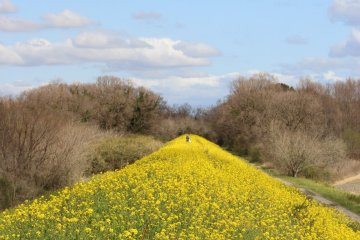

For those in love, looking for love, and everything in between, Kawagoe Hikawa Shrine is the perfect place to visit! Not to be confused with Hikawa Shrine in Omiya Ward, Kawagoe Hikawa Shrine is said to be about 1,500 years old and enshrines five deities, all of who are a part of the same family. Two pairs of the enshrined deities are married, making the Shinto shrine a popular place to pray for good fortune in marriage and family.
The entrance to the shrine is marked by an impressive 15-meter-tall torii gate, which is painted bright orange and said to be the largest wooden torii in Japan. After you pass under the torii, purify yourself at the chozuya by ladling water from the wooden trough onto your hands.
The elegant shrine buildings, interwoven with nature, make for a picturesque environment where positive vibes float on every breeze. Peruse the collection of more than 20 shrine structures of varying sizes and shapes and enjoy the lush nature, which features a tranquil stream running through the grounds. Listed below are Kawagoe Hikawa Shrine’s most popular sights and activities.

Kitain (喜多院), located in Kawagoe, is a 9th-century temple renowned for its collection of 540 playful Rakan (statues of Buddha) and for being home to the only remaining buildings of the former Edo Castle. History Founded in 830 by monk Ennin, Kitain was originally part of a three-temple complex named Muryoju Temple, which included Kitain (North Temple), Nakain (Middle Temple), and Minamiin (South Temple). During the early-14th century, Kitain became the head temple of the Tendai Sect in the Kanto region. Later, in 1599, it became the main temple of Muryoju under the guidance of head monk Tenkai, who had strong relationships with the first three shogun of the Edo Period. In 1638, after a fire destroyed most of Kitain, Shogun Iemitsu ordered several buildings from Edo Castle to be moved to the temple to help rebuild it. Although the fire was tragic, the castle buildings’ relocations likely saved them as Edo Castle was later heavily damaged by the Earthquake of 1923 and World War II. Today Today, Kitain’s preserved castle buildings and whimsical statues make it a must-see spot in Kawagoe. In spring, the temple is especially beautiful when cherry blossoms color the sacred area pastel pink. Other noteworthy spots are the temple’s pagoda and traditional gardens. Wander the tranquil grounds, and find the spots that speak to you. Listed below are Kitain’s top delights:


사이타마 현의 여러 도시와 마을을 지나는 아라카와 제방 순환로를 따라, 현재 수천 개의 놀라운 밝은 노란색 유채꽃이 피었다. 유채꽃 또는 카놀라꽃(일본어로 '나노하나'라고도 함)은 오래 지속되는 꽃이다. 사이타마 현과 일본의 칸토 지역에서는 일반적으로 2월 중순부터 4월 초까지 유채꽃 구경을 할 수 있으며, 3월에는 특히 만발한 모습을 볼 수 있다. 사이타마 현에서는 유채꽃을 특히 강둑을 따라 여러 곳에서 볼 수 있다. 나는 개인적으로 아라카와(아라 강)를 따라 있는 경치를 구경하는데, 특히 가와지마 마을의 아라카와 순환로가 늘어선 경치를 보는 것을 특히 좋아한다. 아게오 시 경계선 쪽에 있는 나카고 데마루에서 오케가와 시 경계에 있는 타로우에몬 다리까지는 대략 4킬로미터에 이른다. 경사면은 주로 자전거 이용자들이 이용하지만 보행자도 이용할 수 있는 공공도로다. 오솔길이 두 갈래로 갈라지는 곳은 자전거를 타는 사람 한 쪽, 그리고 보행자 한 쪽, 이렇게 두 군데밖에 없다. 이 놀라운 아름다움에도 불구하고, 이 지역은 거의 사용되지 않으며, 현재 코로나바이러스 시기에는 경치 좋은 산책을 하기에는 안전한 곳이다. 코스의 데마루 끝에는 훼손되지 않은 숲이 있어 산책도 즐길 수 있다. 그곳에 낚시터도 있다. 근처에는 전동 패러글라이딩 클럽 "에어 윙"(Air Wing)이 있다. 때때로 여러분은 하늘에서 패러글라이딩을 하는 사람들을 볼 수 있지만, 스카이다이빙을 하는 사람들을 보는 것이 더 흔하다. 도쿄 스카이다이빙 클럽은 이 지역에 오피스를 두고 있으며 비행기는 경사면에서도 보이는 혼다 공항에서 출발한다. 타로우에몬 다리 끝에서는 개인 소유의 혼다 공항 주변에서 비행기, 헬리콥터, 스카이다이버 등을 자주 볼 수 있다.